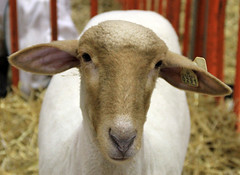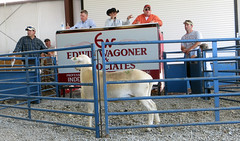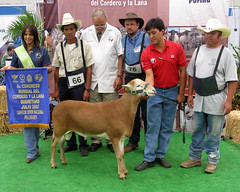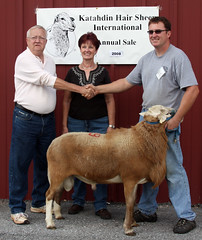- Sheep 201 Index
- Other web sites
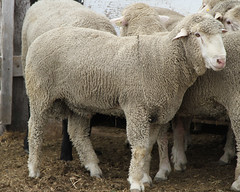
3/4 SAMM x 1/4 Rambouillet
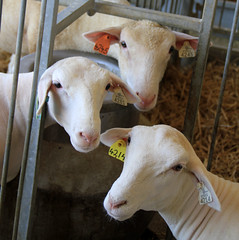
Sale sheep
Producing and selling sheep seedstockSeedstock sales can greatly increase the income derived from a sheep enterprise. Seedstock is another word for breeding stock: animals whose role is to be parents and contribute genes to the next generation.
Seedstock may be purebred or crossbred, registered or unregistered, rams or ewes. They may be of any breed or breed cross, so long as there is a market for them. Some breeds and breed crosses will have more ready markets. Demand will vary by geographic region and segment of the sheep industry.
In the sheep industry, seedstock are produced by universities and agricultural research stations, private companies, and individual producers. Breeding stock usually sell for higher (sometimes much higher) prices than lambs for meat. At the same time, production costs are usually higher (sometimes much higher).
Most of the genetic improvement in the sheep industry occurs in the purebred flocks that produce seedstock. These flocks should be the "elite" flocks of their breed and the industry. Selection should be for economically-important traits. It is ill-advised to chase fads when breeding sheep. The traits that are emphasized in a selection program will vary by breed and the role the breed plays in the commercial sheep industry.
Economically-important traits for commercial sheep production
Early puberty
Fertility
Prolificacy
Mothering ability
Milk production
Pounds of lamb weaned
Easy care
Parasite resistance
Resistance to foot rot
Longevity
Fleece traits
Lamb vigor
Lamb survival
Post-weaning growth
Feed efficiency
Carcass traits
Scrapie resistanceOnly sheep that are structurally and reproductively sound should be kept and sold for breeding. Rams should be held to more stringent standards than ewes. Only a small percentage of rams should be sold for breeding. The majority of ram lambs should be sold for meat. Rams and ewes which do not meet requirements for breed registry should not be registered. However, if they are physically sound, they can be sold as commercial breeding stock.
Breed registries
Breed registries play an important role in the production and marketing of seedstock. Breed associations set the standards for their breed, determine eligibility for registration, and advertise their breed to the sheep industry and greater agricultural community. Participation in the National Sheep Improvement Program (NSIP) is usually done through breed associations.
Higher standards of health
Sheep producers who sell breeding stock should strive for higher animal health standards. Biosecurity is of primary importance. Closed (or mostly closed) flocks should be maintained. Seedstock producers are encouraged to enroll their flocks in the Voluntary Scrapie Flock Certification Program. Some producers genotype their rams for scrapie resistance and provide this information to their potential buyers.
It goes without saying that seedstock flocks should be free from footrot, pinkeye, soremouth, caseous lymphanenditis, epididymitis, and other contagious diseases. In the very least, the presence of these diseases on a farm or in the past should be disclosed to potential buyers. Ideally, the flock should be tested for OPP (ovine progressive pneumonia). It is also possible to test for Johne's disease, Q fever, caseous lymphadentitis (CL).
Performance record keeping
Seedstock producers should keep detailed flock records. Birth records should be kept. Lambs should be weighed to determine weaning weights, and post-weaning rate-of-gain. Weaning weights should be adjusted for sex of lamb, type of birth and rearing, and age of dam. Comparisons should only be made among lambs in the same contemporary group (same management and feeding regime).
Producers of terminal sire breeds should consider collecting data on carcass traits. Lambs can be scanned with ultrasound to determine loin depth and back fat. Central performance tests usually measure carcass traits. Like other data, carcass data needs to be adjusted to allow proper comparison of animals. Usually carcass data is adjusted to a common end point (weight or finish).
All seedstock producers should consider enrolling their flocks in the National Sheep Improvement Program (NSIP). NSIP calculates across-flock EBVs for sheep and goats. EBV stands for "estimated breeding value." EBVs provide an estimate of the genetic value of an animal. Lambs with superior EBVs are predicted to produce offspring which have superior performance as compared to the breed average. EBVs are calculated for various growth, reproductive, fitness, and fleece traits. EBVs are the only accurate way to compare animals from different flocks.
While any breed can submit data to NSIP, a core group of breeders (from a breed) is necessary is necessary to generate across-flock EBVs. Currently, the US breeds that are most active in NSIP are Katahdin, Targhee, and Polypay. Participation is increasing in other breeds. Other countries have similar computerized performance record keeping programs and sire referencing schemes.Central performance tests are an alternative to NSIP. A central performance test is where rams from different flocks are brought to a central location to evaluate performance. While any breed of ram can be consigned, central performance tests are ideal for terminal sire breeds, such as Hampshire, Suffolk, and Texel. Maternal traits cannot be evaluated at a test station. Progeny tests are a more accurate method of selection, but are not common in the US.
Advertising
Sheep do not sell themselves. Some form of advertising is usually necessary to sell seedstock. Signs at the entrance to the farm or on the farm truck or trailer are a good start. Advertising in newspapers and magazines should be considered. A web site is an excellent way to promote breeding stock sales. There are many web sites that list farms for free. Social media, especially Facebook, is becoming an increasingly common way to sell livestock. While Facebook forbids selling animals, there are "work-arounds." Exhibiting sheep at shows, fairs, and festivals is another way to promote breeding stock.
Export
There is a growing export market for U.S. sheep genetics. United States Livestock Genetics Export, Inc. (USLGE) is a national not-for-profit trade association that facilitates the export of cattle, swine, sheep, and goats to other countries.
There is a lot of extra work associated with export sales. Animal health is the most important aspect. Each country has requirements pertaining to the importation of live animals, semen, and embryos. Due to disease issues, some countries requirements are more stringent than others.
Diseases of concern for export include scrapie, bluetongue, foot-and-mouth disease, and brucellosis. Due to diseases issues, semen and embryos have greater potential for export, as they present limited disease risk. Scrapie and bovine spongiform encephalopathy ("mad cow" disease) are the greatest barriers to international trade.
<== SHEEP 201 INDEX
Copyright© 2021. Sheep 101 and 201.


